Assistant Editor Jess Jelsma Masterton: In a typical week at CR, I read through anywhere from twenty-five to forty submissions, from 500 word miCRos to 8000+word stories, novel excerpts, and essays. While my tastes run the gambit from lyric fabulist fiction to hyperrealism, there is one aspect guaranteed to pull me out of an otherwise well-written piece: the flat or otherwise unrealistic characterization of a woman, be it a minor character or the piece’s central protagonist.
 Much has been written about the problem of how women are characterized in fiction, with a particular focus on what men tend to get wrong in their novels and short stories. Bored Panda has compiled this list of Tumblr posts addressing the topic, and back in March, author Whit Reynolds issued a challenge on Twitter, asking their followers to describe themselves “as a male author would.” The results were hilarious, but also telling. As many followers pointed out, the problem is not only present in contemporary fiction, but embedded in the historical canon, with Philip Roth and John Updike offered up as two of literature’s biggest offenders.
Much has been written about the problem of how women are characterized in fiction, with a particular focus on what men tend to get wrong in their novels and short stories. Bored Panda has compiled this list of Tumblr posts addressing the topic, and back in March, author Whit Reynolds issued a challenge on Twitter, asking their followers to describe themselves “as a male author would.” The results were hilarious, but also telling. As many followers pointed out, the problem is not only present in contemporary fiction, but embedded in the historical canon, with Philip Roth and John Updike offered up as two of literature’s biggest offenders.
So, what do I consider a flat or unrealistic characterization when it comes to women? Perhaps the best way to address this question is to put forward a few general examples of “stories that have stopped me in my tracks.”
Example 1, “The Fantasy Story”: An older (generally) male protagonist meets a beautiful young woman who is head-over-heels for him. The reader is never made privy to the woman’s motivation (why is she so attracted to this older man again?), and ample descriptions of the woman’s body ensue (her heaving bosom, her ample derriere—you get the picture).
Example 2, “The I’m-Enraged-by-a-Woman’s Appearance-and/or-Personality Story”: A youngish (generally) male protagonist is forced into a situation that places him in close proximity to the aforementioned woman. They could be trapped together on a plane, in a work group, in the same hotel following a convention—you name it. The man is disgusted by the woman’s appearance and/or personality. The woman is either overweight (deemed unacceptable), mannish (also deemed unacceptable), or has an “acceptable” body but a “detestable” personality (usually neurotic or overbearing). The woman pursues the man, despite his clear objections. As with the first example, we are never made privy to the woman’s motivation (why is she after this man anyway?). The woman serves only as a flat, dehumanized antagonist. She has no worthy thoughts, goals, or even backstory of her own.
Example 3, “The I-Can’t-Stop-Thinking-About-My-Body Story”: A woman protagonist can’t stop thinking about her body. Not about the safety of her body or how her body is or is not allowed to occupy certain spaces, but about her physical anatomy. She thinks about the way her bosom stretches her t-shirt, how she must look to the (generally older) men in the surrounding coffee shop. Though her mother has just died, she takes comfort in the way her funeral dress shows off her “curvaceous figure.” Even when thrust into a life or death situation, her primary thought is how she must appear to her attacker. What does the burglar think of her, having just caught her after a shower? Is he disgusted by the cellulite on her thighs? Attracted? In this story, women often stand, naked, in front of mirrors, examining every inch of their body. Best case: the woman likes what she sees. Worst case: the reader is treated to a detailed description of everything that is not up to snuff, from the woman’s uneven breasts to the drooping curve of her stomach. As with the last two examples, the woman is not a person with complicated wants and desires. She is an empty vessel, defined solely by her body and the ways in which others perceive it.

As for writing a well-characterized and realistic woman? My suggestion is to start with the basics. All characters, regardless of identity, need a central motivation that aligns with their previous life experience. While characters are naturally flawed, they are also humans with complicated thoughts and emotions. Characters, especially women, should not be placed in a story solely to help a protagonist on his journey (manic pixie dream girl, anyone?). Realistic characters create tension precisely because their goals and points of view do not entirely overlap. Two people both want a child but argue over the timing (should they get pregnant now or wait until their financial situation is more stable?). Two friends agree to cohost a birthday party but have a falling out when the Type A confronts the Type B about not pulling her weight in the planning.
And remember: even antagonists and outright villains are still people at the end of the day. As Stephen King writes in On Writing: A Memoir of the Craft, “no one is ‘the bad guy’ or ‘the whore with the heart of gold’ in real life; in real life we each of us regard ourselves as the main character, the protagonist, the big cheese; the camera is on us, baby. If you can bring this attitude into your fiction, you may not find it easier to create brilliant characters, but it will be harder for you to create the sort of one-dimensional dopes that populate so much pop fiction.”
So write your realistic, complicated, and flawed women—women with motivations outside of imposing their bodies on others or impressing men—and send them our way.











